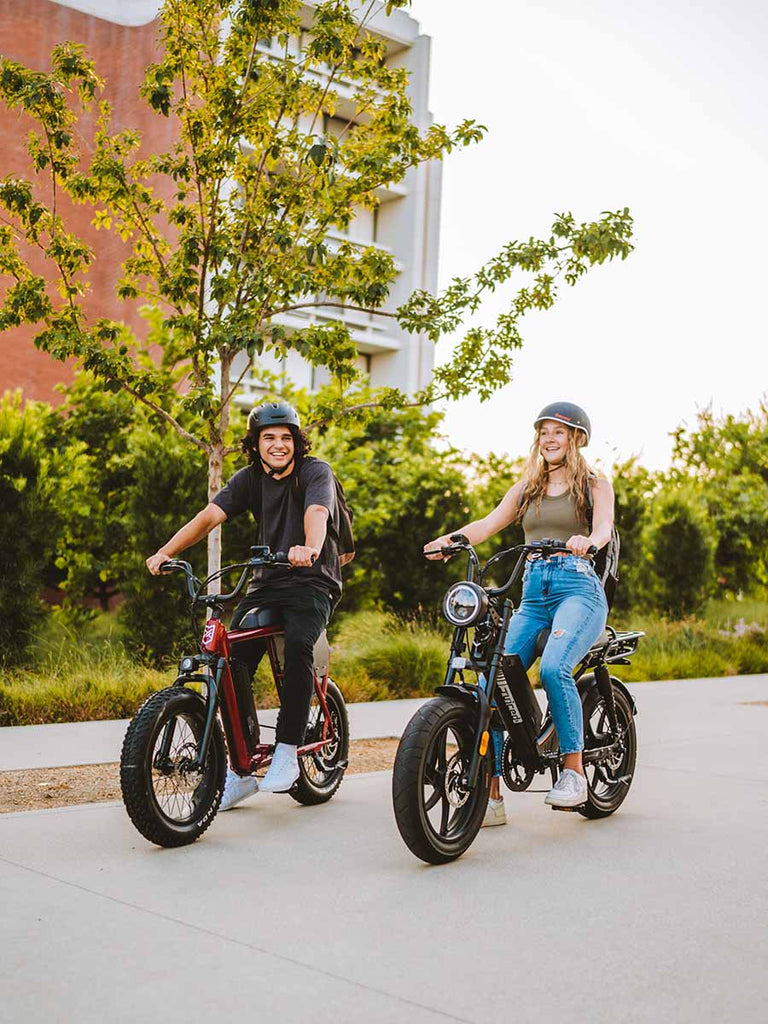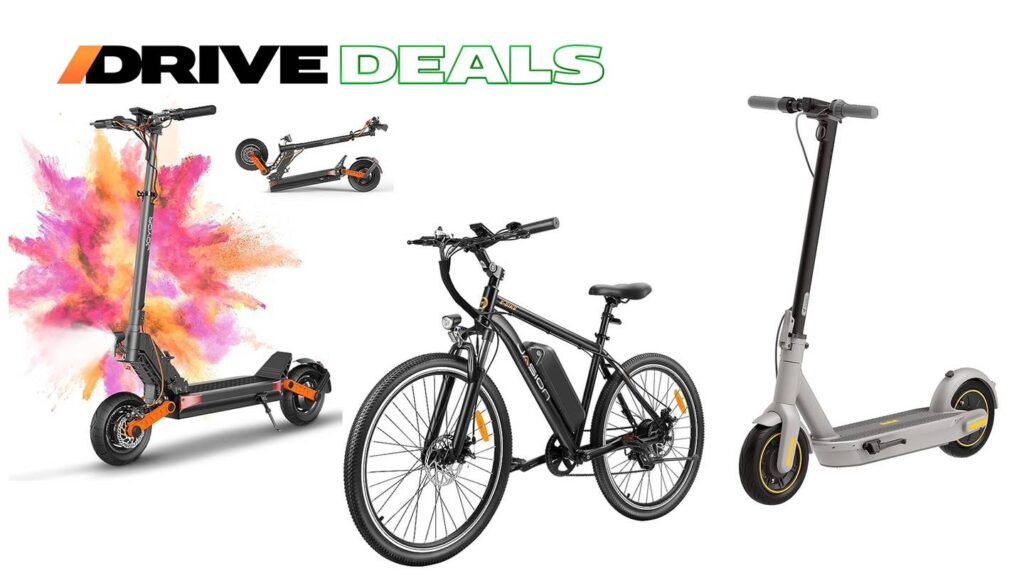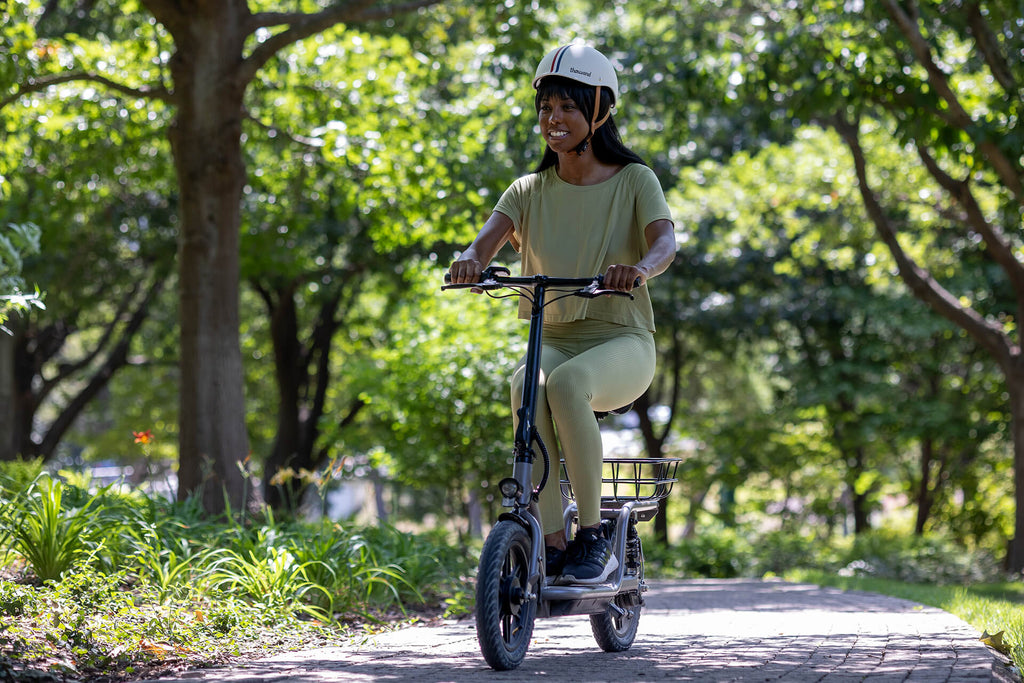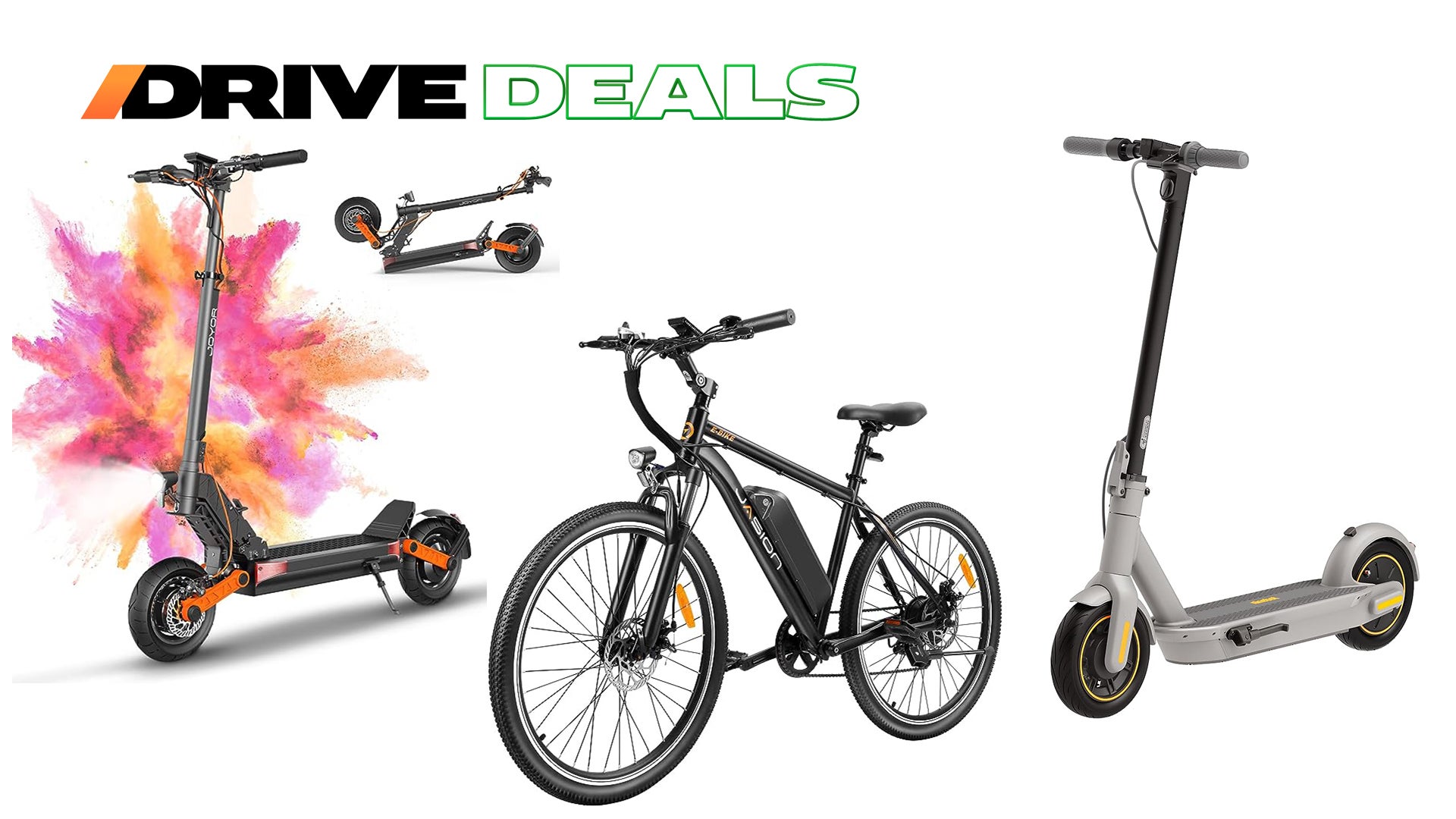Are you a student getting ready to head back to school? Are you tired of dealing with crowded buses and long walks to class? If so, you may be considering an alternative mode of transportation that is both efficient and eco-friendly. In this article, we will explore the options of electric scooters and electric bikes, providing you with the information you need to make the best choice for your daily commute. Whether you’re navigating busy city streets or cruising through campus, we’ve got you covered with beginner-friendly tips and insights. Say goodbye to the hassle of public transportation and hello to a convenient and exciting way to get to class. Let’s dive into the world of electric scooters and electric bikes and find out which one suits your needs best.

This image is property of cdn.shopify.com.
1. Cost
1.1 Initial cost
When it comes to choosing between an electric scooter or an electric bike, one of the important factors to consider is the initial cost. Electric scooters generally have a lower upfront cost compared to electric bikes. This means that if you’re looking for a more affordable option, an electric scooter might be the way to go. However, it’s important to keep in mind that the initial cost can vary depending on the brand, model, and features of the scooter or bike you choose.
1.2 Maintenance cost
Another cost consideration is the maintenance cost. Electric scooters generally require less maintenance compared to electric bikes. Scooters typically have fewer moving parts and simpler mechanisms, which means that there are fewer components that can potentially break down or require regular servicing. On the other hand, electric bikes often have more complex systems such as gears, chains, and brakes, which may require more frequent maintenance or repairs. It’s important to factor in the potential costs of maintenance when making your decision.
1.3 Cost of accessories
In addition to the initial and maintenance costs, it’s also important to consider the cost of accessories. Both electric scooters and electric bikes may require additional accessories such as helmets, lights, locks, and storage solutions. These accessories not only add convenience and safety to your rides but can also add to the overall cost. It’s important to research and budget for the necessary accessories that you may need for your chosen mode of transportation.
2. Speed and Range
2.1 Speed
Electric scooters are generally designed for shorter distances and lower speeds. They are commonly used for last-mile commuting or leisurely rides around the neighborhood. Most electric scooters have a top speed of around 15-20 mph, which is well-suited for urban environments with lower speed limits. Electric bikes, on the other hand, can offer higher speeds depending on the model and type. Some electric bikes can reach speeds of up to 28 mph or even higher. If speed is an important factor for you, an electric bike may be the better option.
2.2 Range
Another important factor to consider is the range, or the distance that the scooter or bike can travel on a single charge. Electric scooters generally have a shorter range compared to electric bikes. They are typically designed for shorter commutes and have a range of around 10-25 miles depending on the battery capacity and riding conditions. Electric bikes, on the other hand, can offer a longer range and are suitable for longer commutes or recreational rides. Some electric bikes can have a range of up to 50-100 miles, depending on the battery capacity and level of pedal assistance. Consider your daily commute or riding needs and choose the option that offers a range that aligns with your requirements.
3. Safety
3.1 Stability
Stability is an important consideration when choosing between an electric scooter and an electric bike, especially if you’re new to riding. Electric scooters generally have a lower center of gravity and a wider wheelbase, which can provide better stability and balance at lower speeds. They are designed to be more maneuverable and agile, making them a good option for navigating through tight spaces or crowded urban environments. Electric bikes, on the other hand, may require more balance and stability, especially at higher speeds. They usually have narrower wheelbases and can feel less stable to beginners. If stability is a concern for you, an electric scooter may be a safer option.
3.2 Braking system
The braking system is crucial for the safety of any electric scooter or electric bike. Electric scooters typically have a hand-operated brake lever on the handlebars, similar to traditional bicycles. Some models may also have additional features such as electronic braking systems or regenerative braking, which can help improve safety and control. Electric bikes, on the other hand, often have more advanced braking systems, including hydraulic disc brakes or even regenerative braking. These braking systems offer better stopping power and control, especially at higher speeds. If safety is your top priority, consider the braking system of the scooter or bike you are considering.
3.3 Visibility
Visibility is an important aspect of safety, especially when riding in busy urban environments. Both electric scooters and electric bikes should have adequate lighting systems to ensure visibility to other road users. Look for models that have bright and efficient front and rear lights, as well as reflectors for increased visibility during nighttime rides. Additionally, wearing bright and reflective clothing can further enhance your visibility on the road. Always prioritize safety and ensure that your chosen mode of transportation offers good visibility features.
4. Commute
4.1 Distance
When considering an electric scooter or an electric bike for your commute, it’s essential to assess the distance you’ll be traveling on a daily basis. Electric scooters are generally designed for shorter commutes, such as traveling within a neighborhood or for last-mile transportation. With their smaller wheels and lower range, they are better suited for shorter distances of around 10 miles or less. Electric bikes, on the other hand, are suitable for longer commutes. They can cover distances ranging from 20 to 50 miles or more, depending on the battery capacity and level of pedal assistance. Consider the average distance of your daily commute and choose the mode of transportation that matches your needs.
4.2 Traffic conditions
Traffic conditions are another crucial factor to consider when choosing between an electric scooter and an electric bike. Electric scooters are well-suited for navigating through congested urban areas where traffic is heavy or during peak commuting hours. Their maneuverability and smaller size allow riders to easily navigate through tight spaces and avoid traffic congestion. Electric bikes, on the other hand, may require more space and can be less maneuverable in heavy traffic. However, if your commute involves mainly open roads or bike lanes, an electric bike can offer a smooth and efficient ride. Assess the traffic conditions of your commute and choose accordingly.
4.3 Parking
Parking is often a challenge in urban areas, and it’s important to consider the parking options available for your chosen mode of transportation. Electric scooters have the advantage of being compact and lightweight, which makes them easier to park and store. They can be parked in designated scooter parking areas or even carried indoors if allowed. Electric bikes, on the other hand, may require more space for parking. They typically require a bike rack or a secure place to lock them up. If parking is an issue in your area, consider the convenience of parking and storage for both electric scooters and electric bikes.

This image is property of www.thedrive.com.
5. Environment
5.1 Carbon footprint
Reducing our carbon footprint is becoming increasingly important, and choosing a sustainable mode of transportation can make a significant impact. Both electric scooters and electric bikes are eco-friendly alternatives to traditional gasoline-powered vehicles. They produce zero emissions during operation and contribute less to air pollution. However, electric bikes are generally considered to have a lower carbon footprint compared to electric scooters. This is because electric bikes often require less battery power due to the rider’s assistance through pedaling. If minimizing your carbon footprint is a priority, an electric bike may be the more environmentally friendly choice.
5.2 Noise pollution
In addition to reducing air pollution, electric scooters and electric bikes also have the advantage of reducing noise pollution. Traditional gasoline-powered vehicles are known for their noise levels, which can contribute to a less peaceful and enjoyable urban environment. Electric scooters and electric bikes, on the other hand, produce minimal noise during operation. This can make for a more pleasant riding experience and contribute to a quieter and more peaceful neighborhood. Consider the impact of noise pollution and choose a mode of transportation that aligns with your preferences for a quieter environment.
6. Storage and Portability
6.1 Size and weight
When it comes to storage and portability, electric scooters generally have an advantage over electric bikes. Electric scooters are compact and lightweight, making them easy to carry and store. They can be folded or disassembled, allowing you to bring them indoors or store them in small spaces. Electric bikes, on the other hand, can be bulkier and heavier, which may make them more challenging to store or transport. They usually require a dedicated bike rack or storage space. If you have limited storage space or need a mode of transportation that can be easily carried, an electric scooter may be the better option.
6.2 Folding mechanism
The folding mechanism is a feature specific to electric scooters that adds to their convenience and portability. Many electric scooters come with a folding mechanism that allows you to collapse the scooter for easier storage or transportation. This makes them ideal for commuters who need to bring their scooters onto public transportation or store them in tight spaces. Electric bikes, on the other hand, do not typically have a folding mechanism and require a larger storage space. Consider your specific storage and portability needs when making your decision.

This image is property of cdn.shopify.com.
7. Health and Fitness
7.1 Physical activity
Incorporating physical activity into your daily routine is crucial for maintaining good health and fitness. Electric scooters, although fun to ride, do not require much physical effort. They are propelled solely by the electric motor and don’t require pedaling. Electric bikes, on the other hand, offer the option to pedal and provide varying levels of pedal assistance. This means you can choose to get a workout by pedaling or utilize more motor assistance for a relaxed ride. If improving or maintaining your fitness level is important to you, an electric bike can offer the benefits of both exercise and motor assistance.
7.2 Impact on body
Riding an electric scooter or an electric bike can have different impacts on your body. Electric scooters provide a more relaxed and effortless ride, with minimal impact on your joints and muscles. They are suitable for individuals who may have mobility issues or prefer a more leisurely ride. Electric bikes, on the other hand, require pedaling and can offer a more intense workout depending on the amount of pedal assistance chosen. They can help improve cardiovascular health, strengthen muscles, and increase endurance. Consider your fitness goals and any physical limitations when deciding between an electric scooter and an electric bike.
8. Fun and Enjoyment
8.1 Adrenaline rush
If you’re looking for a mode of transportation that offers an adrenaline rush and a thrilling experience, both electric scooters and electric bikes can provide that. Electric scooters, with their lower speed and maneuverability, can offer a fun and exciting ride. They are perfect for zipping around the neighborhood or exploring new areas with a sense of freedom. Electric bikes, on the other hand, can provide a more exhilarating experience, especially if you choose a model with higher speeds and powerful motors. They can take you on scenic routes and allow you to explore new destinations with ease. Consider your preference for speed and the level of excitement you’re seeking when choosing between an electric scooter and an electric bike.
8.2 Scenic routes
One of the joys of riding an electric scooter or an electric bike is the ability to take scenic routes and appreciate the beauty of your surroundings. Both modes of transportation allow you to explore your surroundings at a slower pace, giving you the opportunity to enjoy the scenery. Electric scooters are great for leisurely rides around parks or along beach promenades. Electric bikes, with their longer range, can take you on longer journeys and help you discover new trails, parks, or picturesque neighborhoods. Consider your desire for exploring scenic routes and the type of environment you want to enjoy during your rides.

This image is property of cdn.shopify.com.
9. Trendiness
9.1 Popularity
In recent years, both electric scooters and electric bikes have gained popularity as alternative modes of transportation. Electric scooters, in particular, have experienced a surge in popularity due to their convenience and ease of use. They are commonly used for short commutes, shared mobility services, or leisurely rides around town. Electric bikes, on the other hand, have a longer history and have been a popular choice for commuters and recreational riders. Their popularity is growing as more people recognize the benefits of electric bikes for both transportation and fitness. Consider the trendiness and popularity of each mode of transportation and choose the one that aligns with your preferences.
9.2 Style
Style is another factor that may influence your decision between an electric scooter and an electric bike. Electric scooters often come in sleek and modern designs, catering to a younger and more fashion-conscious demographic. They are available in a variety of colors and styles to suit personal preferences. Electric bikes, on the other hand, have a wider range of styles, including commuter bikes, mountain bikes, and even retro-inspired models. They offer more customization options, allowing riders to choose the design and style that matches their personality. Consider your personal style preferences and choose the mode of transportation that reflects your individuality.
10. Legal Considerations
10.1 Regulations
Before choosing between an electric scooter and an electric bike, it’s important to familiarize yourself with the local regulations and laws regarding their use. Electric scooters are subject to different regulations in different areas, and some cities have specific rules regarding the use of shared electric scooters. It’s important to check if electric scooters are legal in your area, whether they can be ridden on bike lanes or sidewalks, and if any age restrictions or helmet requirements are in place. Electric bikes, on the other hand, are generally treated as bicycles and are subject to the same regulations. It’s important to educate yourself about the specific regulations in your area to ensure you ride safely and legally.
10.2 Licensing requirements
Licensing requirements are another important consideration when choosing between an electric scooter and an electric bike. Electric scooters typically do not require a driver’s license to operate, as they are considered low-powered vehicles. However, some areas may require a minimum age limit, and it’s important to check the local regulations. Electric bikes, on the other hand, generally do not require a driver’s license as they are classified as bicycles. However, there may be age restrictions or specific rules regarding the use of electric bikes on certain roads or bike paths. It’s important to understand the licensing requirements in your area and ensure you comply with the necessary regulations.
In conclusion, when deciding between an electric scooter and an electric bike, there are several factors to consider. The initial cost, maintenance cost, and cost of accessories should be taken into account. The speed and range, as well as the safety features and visibility, are important factors to ensure a comfortable ride. Consider the distance of your commute, the traffic conditions, and the parking options available to you. The environmental impact, including the carbon footprint and noise pollution, can also play a significant role in your decision. Assess the storage and portability options, as well as the impact on your health and fitness. Take into consideration the fun and enjoyment factor, as well as the trendiness and style of each mode of transportation. Lastly, familiarize yourself with the legal considerations, including the regulations and licensing requirements. By considering all these factors, you can make an informed decision and choose the mode of transportation that best suits your needs and preferences.




